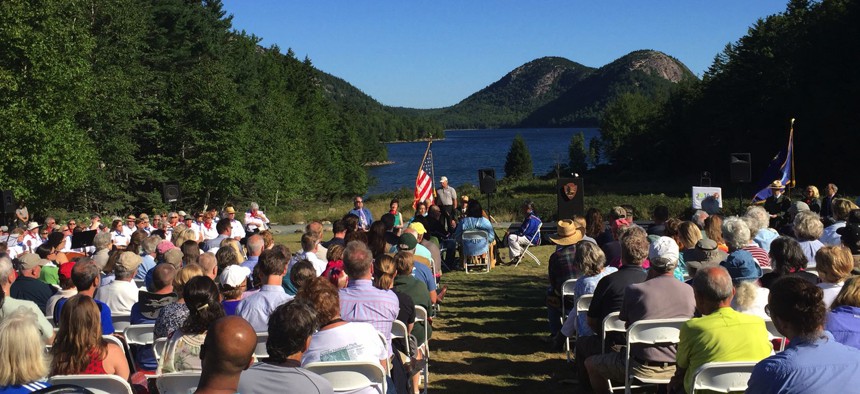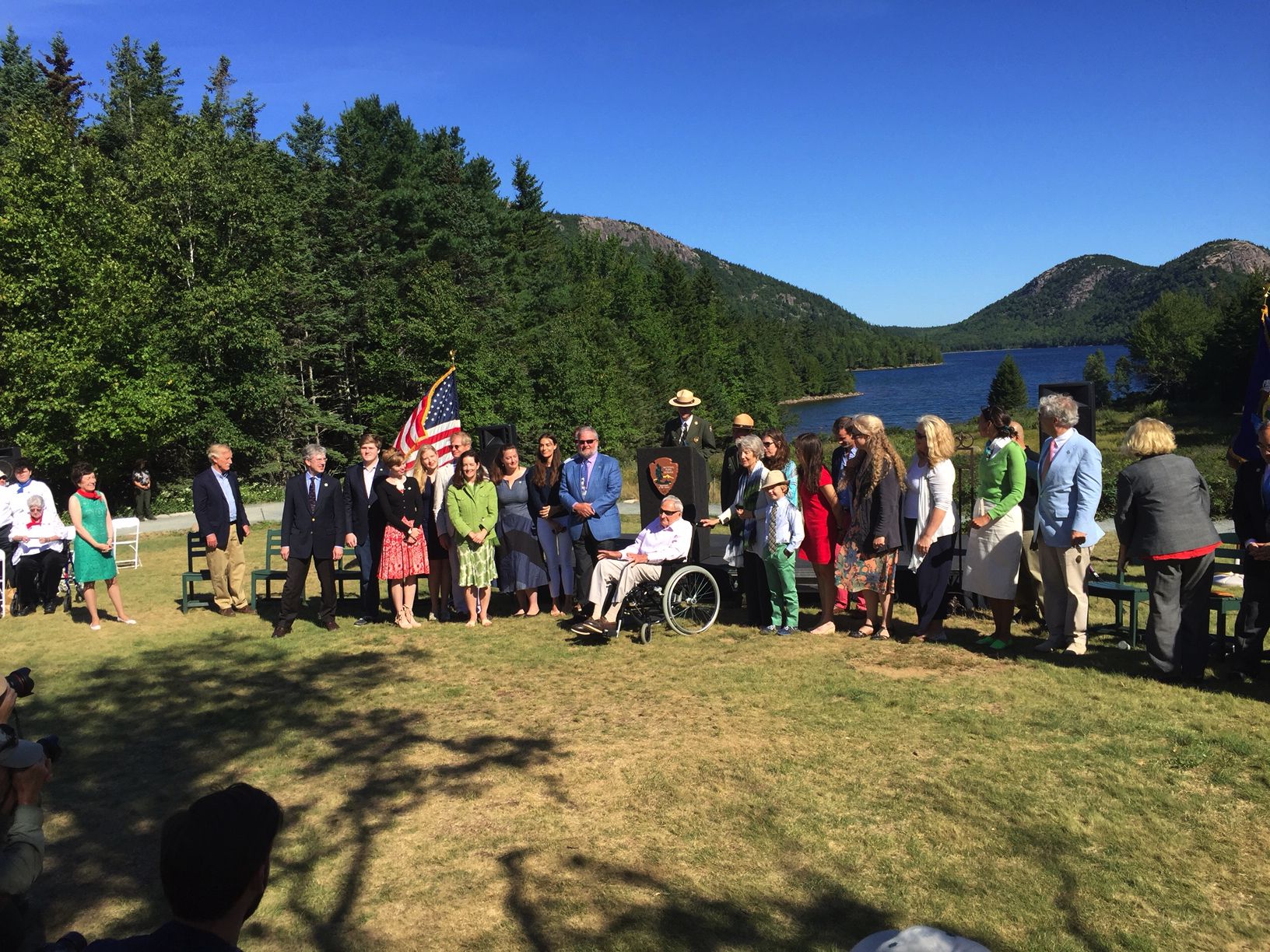As Acadia Nat’l Park Celebrates Centennial, Maine Gets New Nat’l Monument

This weekend's ceremony at Acadia National Park to celebrate the park's centennial. Timothy B. Clark / RouteFifty.com
Soon after President Obama’s pen stroke made a long-discussed Katahdin Woods proposal official, Interior Secretary Sally Jewell explored the area’s ‘beauty and the bounty’ by canoe.
ACADIA NATIONAL PARK, Maine — Just as the National Park Service has been marking its own centennial, the Pine Tree State’s entire congressional delegation turned out Saturday here to celebrate what local leaders have characterized as the 100th anniversary of this national park’s founding.
Several hundred people gathered on a lawn facing scenic Jordan Pond and surrounding mountains to hear from officials including Maine’s U.S. senators, Republican Susan Collins and Independent Angus King and U.S. representatives, Democrat Chellie Pingree and Republican Bruce Polliquin. This bipartisan political contingent was joined by senior National Park Service officials, including Acadia’s superintendent Kevin Schneider and, from Washington, D.C., Michael Reynolds, the Park Service’s new deputy director for operations.
Reynolds declared that the NPS, which now manages 413 parks across the nation, is the only agency in government with a mandate to promote “enjoyment.” At the same time, he noted in a wry comment on bureaucracy, when citizens suggest “a good idea, we write a regulation” to make it happen.
Speakers celebrated both Acadia and the National Park System, “America’s Best Idea,” as it was called in the title of documentary producer Ken Burns’ six-part series on the parks. Each of the members of Congress spoke movingly of Acadia’s role in their lives. Collins, for example, told of growing up in Caribou, in the far western reaches of rural Aroostook County, some 200 miles from the Maine coast. It wasn’t until she was 12 years old that her parents decided she must see the ocean—and took her to Acadia National Park.

The celebration focused on the role that citizens and private organizations have played in creating and nurturing the national parks. In particular, the Rockefeller family was honored here on Saturday, in recognition of their contribution of land, money and effort to Acadia. David Rockefeller, now 101 and present at the ceremony, has led his generation’s devotion to the park, following on the extensive work done by his father, John D. Rockefeller Jr.
That work included creating a system of beautiful carriage trails and stone bridges much beloved by bicyclists and walkers. The Park Service unveiled a new Rockefeller Plaque to be installed near Otter Point later this year, celebrating their role in Acadia. David Jr., now in his 70s, and about two dozen younger Rockefellers turned out for the celebration.

A few days before the celebration, the Park Service announced that it would give the annual Director’s Partnership Award to private Acadia support organizations. One long-established recipient was Friends of Acadia, a nonprofit organization that raises and spends more than $2 million a year to help the park with transportation, land acquisition and other needs. The second honoree was the Acadia Centennial Task Force, created in 2012 to promote recognition of the park. The task force attracted more than 450 business, nonprofit and individual supporters throughout Maine.
Historians might note that the centennial observed Saturday was not of the date the park was actually created by enactment of a law. That occurred on Feb. 26, 1919, when President Woodrow Wilson signed a law creating Lafayette National Park. The name was changed to Acadia in 1929.
The centennial was actually of President Wilson’s executive action on July 8, 1916, to establish a National Monument called Sieur du Monts. He used authority granted by Congress in the Antiquities Act of 1906, created during the conservationist presidency of Theodore Roosevelt. Seven weeks later on Aug. 25, 1916, Wilson signed a law to create the National Park Service.
Though the ceremonies here steered mostly clear of politics, allusion was made to the most recent use of the Antiquities Act—by President Obama on Aug. 24 to create the Katahdin Woods and Waters National Monument further north and west in Maine. Like Acadia, this monument is built around a family’s large donation of land. The new monument has been bitterly opposed by timber interests and local citizens in the depressed Millinocket region, as Route Fifty has previously explored.
On the same weekend as the Acadia festivities, Interior Secretary Sally Jewell was exploring Katahdin Woods by canoe to sample its beauty and recreational opportunities by canoe, the Portland Press Herald reported. “Now all will have an opportunity to experience the beauty and the bounty of the Maine woods,” she said, according to the newspaper.
Perhaps there’s hope that this new monument will, like Acadia, create new jobs for Maine.
Jewell is hopeful for the future, the Press Herald reported: “Business will increase, opportunities will increase.”
Pingree, speaking at the Acadia ceremony on Saturday, spoke poignantly of the thousand of jobs lost in Maine as paper mills, textile plants and shoe manufacturers have closed down. In their place, Acadia has become “so darned important,” she said, “an economic engine for mid-coast Maine, generating $300 million in business and more than 4,000 jobs.”
Timothy B. Clark is Editor-at-Large at Government Executive’s Route Fifty and is a fellow and former board member at the National Academy of Public Administration.
NEXT STORY: Maine Governor Leaves Shocking Voicemail; D.C.’s 9-1-1 System Fails






